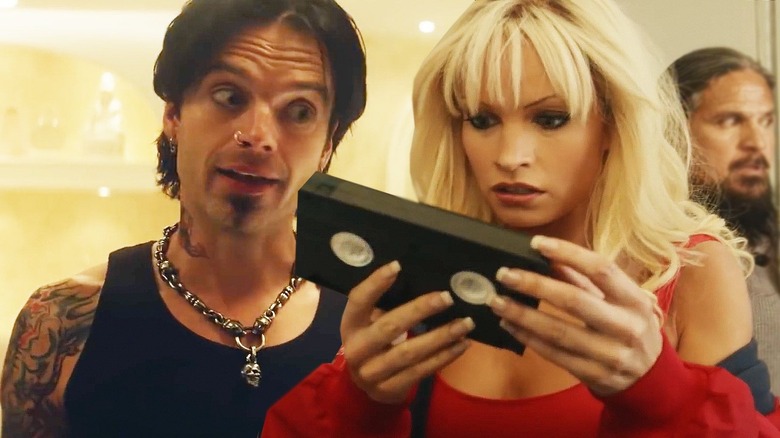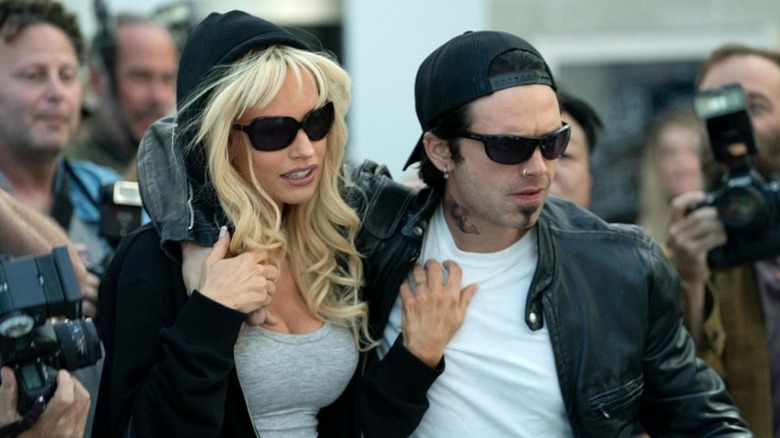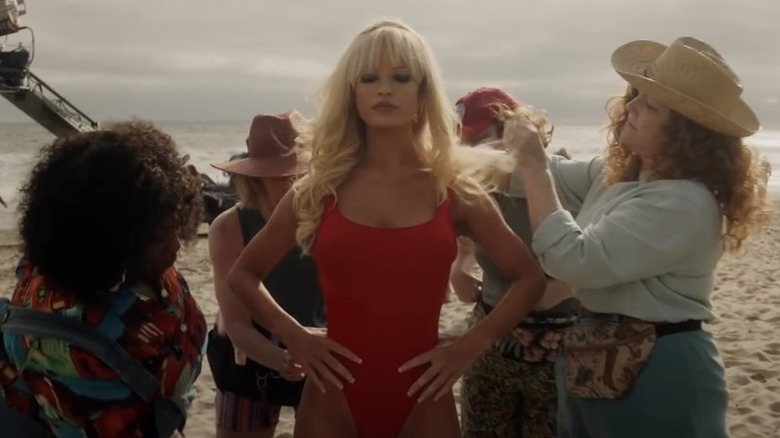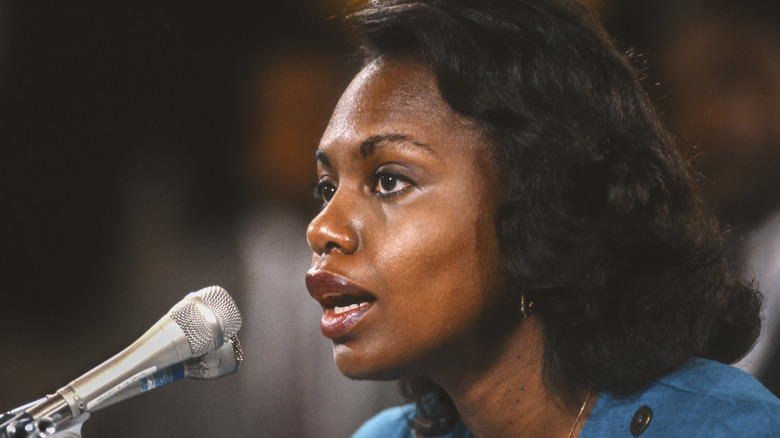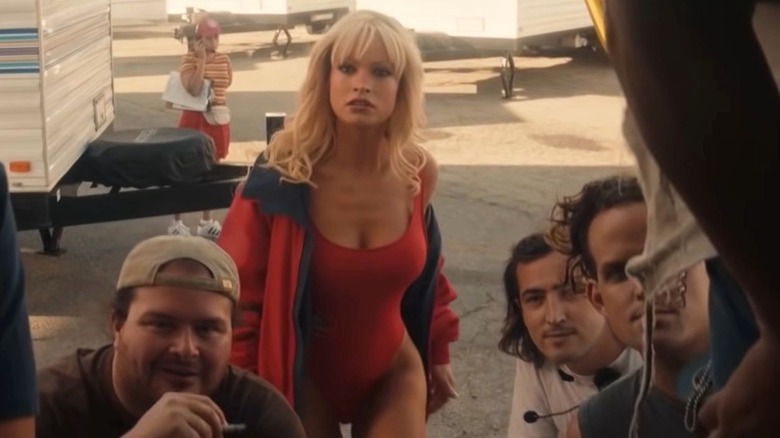Pam & Tommy Shows Just How Awful The Media Was To Women In The '90s
Episode 1 of "Pam & Tommy" opens with a fictionalized version of an interview between longtime late night host Jay Leno and "Baywatch" alumna Pamela Anderson. The scene struck me as being particularly sleazy, and I thought to myself, "there's no way a respected, mainstream television host would get away with that behavior today."
Being the research-loving nerd I am, I looked up the real interviews, and while the exact exchange depicted in the show doesn't appear to have taken place, the real life comments that inspired them aren't much better. In the clip below, Leno couldn't help making a tasteless comment about Anderson's breasts while she shared details about her pregnancy.
In addition to the media's awful treatment of Anderson in the wake of her and her now-ex husband's sex tape, "Pam & Tommy" brings to mind plenty of other examples illustrating how the '90s reveled in brazen misogyny.
Collateral damage & punchlines
Watching "Pam & Tommy," I couldn't help recalling another TV series that recounted the details of a different '90s sex scandal: Impeachment: American Crime Story. In "Impeachment," on which Monica Lewinsky served as a consultant and producer, the events leading up to, and immediately following the Clinton-Lewinsky affair are detailed, with much of the series focusing on the impact it had on Monica, who was only 21 years old when the affair with former President Bill Clinton — then 49 years old — began. In the case of both Pamela Anderson and Monica Lewinsky, the two women were made subject to extreme media scrutiny and controversy during the '90s as a result of their private lives and acts being made public against their will. They were regarded as punchlines and collateral damage in advancing the political agendas and personal grudges between vengeful men and entities.
Anderson suffered career setbacks and emotional distress as a result of Rand Gauthier's beef with Tommy Lee. While Lee is objectively a jerk for not paying the former contractor for services rendered, Gauthier violated their home and privacy, and his act of "karmic" revenge went beyond just getting even with Lee. The theft and distribution of the couple's private sex tape dealt much more damage to Anderson than Lee, but I suppose Gauthier didn't stop to consider how his actions could have harmed her, the same way the media of the '90s — well before the #MeToo era or widespread revenge porn laws — disregarded the harm being done to women who were unfairly used as pawns, joke fodder, and cash cows at the expense of their personhood.
The mainstream consideration for things like consent and mental health in mass media is only heartbreakingly, shockingly recent — as evidenced by the prevailing idea that Anderson somehow forfeited her right to privacy or objection concerning the unauthorized theft and distribution of the tape she recorded with her then-husband because she consented to shooting risqué photos for Playboy years prior. The difference was in the consent of the woman at the center of it all, and the media of the '90s wasn't concerned with it at all.
Mainstream misogyny
It's actually kind of insane to think in retrospect, that a woman having sex with her own husband was seen as such a scandalous act in of itself, and that scores of people were eager to watch and vilify her for doing something that nobody else was ever meant to see. It clearly goes beyond just the simultaneous fascination with and dehumanization of celebrities, because despite the fact that both Anderson and Lee recorded and appeared in the stolen tape together, only Anderson was made to be the primary joke and villain. It was blatant misogyny, and there was no significant pushback against it. It was just the norm. People were eager to see Anderson engaging in private sexual acts with her husband, and just as eager to look down on her for it. Anderson was far from the first or last woman of the '90s (or any decade, really) to be the subject of less-than-consensual sexual content marketed to the masses.
Take "Girls Gone Wild" for instance. Launched by professional sleazeball Joe Francis in 1997, the premise was to capitalize on the sexual coercion of mostly-drunk women, encouraging them to expose themselves on camera. The videos of their consensually murky exploits were then sold to perverts. By 2002, the franchise had produced 83 "Girls Gone Wild" videos, and 30-minute infomercials for them were airing on every mainstream major television network.
That same year, a Florida judge threw out a case in which a woman claimed that "Girls Gone Wild" used footage of her baring her breasts without her consent in two of these advertisements. Although she was 17 at the time the tape was recorded, her status as a minor who could not have legally consented was not enough for her case to be taken seriously in a court of law. Never mind the fact that individuals under the influence of alcohol and other substances — like many of the young women featured in "Girls Gone Wild" videos — are typically not in a frame of mind to truly consent. The predatory nature of the franchise was just par for the course.
Much in the same way the lack of real consent from the Jane Doe in the aforementioned case didn't seem to make a difference to anyone with the power to change things or help, "Pam & Tommy" makes a point to show how Anderson's lack of consent was routinely dismissed by legal teams, PR people, and even her own husband — a reflection of the larger reality that saw women granted little agency and protection from sexual and emotional violation, and a media culture that delighted and actively played a role in their humiliation.
The mistreatment of Anita Hill
This phenomenon is covered extensively in the book "90s Bitch: Media, Culture, and the Failed Promise of Gender Equality." In it, the unfortunate treatment of Anita Hill is detailed. In 1991, Hill was a Black woman who testified before the Senate Judiciary Committee in order to make a case against Clarence Thomas becoming a Supreme Court Justice due to the years of sexual harassment she experienced while he was her supervisor at the Department of Education and the EEOC. She was made to repeatedly recount the disturbing and disgusting details of the harassment before an audience composed entirely of white men (including current President Joe Biden, who was then a senator) who downplayed the severity of the harassment — including this comment from former-Pennsylvania Senator Arlen Specter, regarding objectively inappropriate comments about women's bodies in a professional setting.
"You testified this morning, in response to Senator Biden, that the most embarrassing question involved — and this is not too bad — women's large breasts. That is a word we use all the time."
A condensed version of Hill's testimony and the abhorrent questions and comments she endured can be found below, courtesy of "Vice."
Unfortunately, the mockery and dismissal of Hill and the allegations were not limited to the hearing; she was mocked, dismissed, and scrutinized in the media as well. SNL even had an entire opening skit dedicated to reducing her claims and experience to nothing more than bad flirting on Thomas' part.
Other women who suffered sexual harassment at the hands of Thomas offered to testify to share their own experiences and back Hill's claims of harassment, but they were never called to do so. Nominated by George H. W. Bush, Thomas would go on to be confirmed as an Associate Justice of the Supreme Court with a 52-48 vote on October 15, 1991. He is still serving to this day.
Hill's treatment by the media and justice system were not unique, and would serve as one of the first in a long line of media field days had at the expense of women who had the misfortune of being caught up in public sex scandals. While men like Clarence Thomas, Joe Francis, Tommy Lee, and former president Bill Clinton, were largely let off the hook for their roles in their respective sex scandals, the women involved — Anita Hill, the aforementioned Jane Doe, Pamela Anderson, and Monica Lewinsky, respectively — were given much harsher, less ambiguous condemnation and dismissal of their pain and experiences. Discussions about power dynamics and consent were not being had in the mainstream media; instead, the women were routinely used as ratings and viewership fodder, with magazines, TV shows, and news broadcasts wringing out every detail of their personal lives and trauma to provide eager audiences with a steady IV drip of misogyny-flavored voyeurism.
An era of exploitation
An upcoming episode of "Pam & Tommy" during which Anderson is made to answer invasive and irrelevant questions about her sexual history during a male-led legal deposition is similarly disturbing. Anderson is interrogated as if anything less than a laughably conservative sexual history and public image could somehow excuse or even justify the violation of privacy that Gauthier and other men committed by stealing and/or redistributing the contents of the private tape she made with her now ex-husband. A crime was being committed against her, yet she was the one being treated as a criminal.
Like many high-profile women of the '90s, her well-being, consent, and personhood were not deemed important or even considered when it came to how their stories were portrayed in the media. It was an era of gendered exploitation, and even with the #MeToo movement and other indicators of change concerning the pervasive sexism of the media and society at large, I have to wonder how much things have truly changed. It's important to note that while "Pam and Tommy" attempts to retroactively paint a more humanizing and nuanced portrait of Anderson and the sex-tape scandal than the media did during the '90s, repeatedly pointing out her lack of consent in all of it, it was ironically done so without her consent or even passive involvement.
